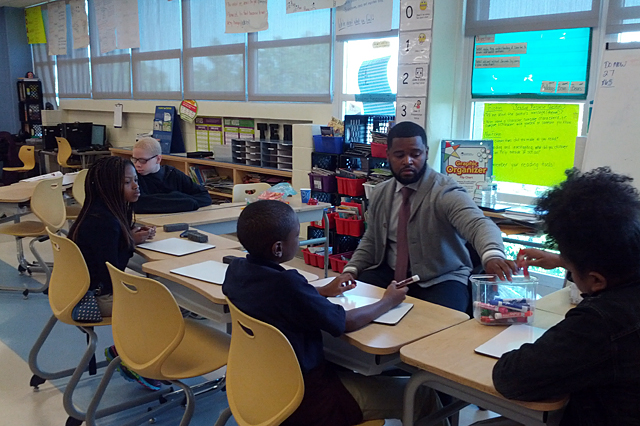Teachers are routinely told they should not stand in the front of the classroom and lecture. They hear that this type of instruction is boring and that they’ll lose students’ attention. Dynamic classrooms get students moving around, working together and engaging in hands-on activities. Particularly as schools emphasize “21st century skills” that prepare students for the modern workplace, teachers are being asked to innovate in their classrooms.

But professional development for those same teachers generally features a presenter at the front of the room, lecturing.
The District of Columbia Public Schools district is among those changing the script. And a two-year-old professional development program called LEAP (for “LEarning together to Advance our Practice”) is being linked to greater achievement among students.
Instead of a handful of professional development days each year, D.C. teachers get a weekly cycle of professional learning. Ninety-minute weekly seminars are a cornerstone of the model. Teachers meet in teams based on their grade levels or content areas led by teacher leaders, instructional coaches or administrators. LEAP also calls for weekly classroom observations for teachers and follow-up debriefs so teachers can get rapid feedback to incorporate into their lessons.
Jessica Rauch, president and executive director of the DC Public Education Fund, a nonprofit that has invested $14 million in the district’s new professional development strategy, said the regular contact with “like-minded” colleagues and routine feedback offers teachers what they need to “be better tomorrow.” The goal is immediate impact.
“Prior to LEAP, there was some professional development that was good, but it was like once or twice a year with a group of people who you didn’t know and wouldn’t see again. That stuff would not stick if you’re doing it twice a year and you never go back to it.”
Noelani Davis, a math teacher and department chair at Coolidge Senior High School in Washington, D.C., as well as a LEAP leader who facilitates seminars and coaches teachers through regular classroom observations, said that’s a far cry from what used to be the norm.
“Prior to LEAP, there was some professional development that was good, but it was like once or twice a year with a group of people who you didn’t know and wouldn’t see again,” Davis said. “That stuff would not stick if you’re doing it twice a year and you never go back to it.”
LEAP, Davis said, gives teachers constant feedback and a chance to implement it right away.
A district analysis of LEAP and its effects* found that schools that run the professional learning program as designed had greater growth in the portion of students scoring ‘proficient’ on state tests. That was true in D.C.’s high-poverty schools, as well as among public schools overall.
LEAP is a districtwide initiative, but some schools have not been able to implement all the program components as designed. Among these schools, there was actually a decrease in the portion of students scoring ‘proficient’ on state math tests, according to the district analysis.
D.C. is not alone in rethinking teacher professional development. Some districts have taken a page from the “flipped learning” handbook, asking teachers to read background materials or watch videos in advance of actual seminars. The in-person time then gets spent with more engaging, hands-on activities. There are also districts in which “personalized learning” extends to teachers as well as students. Professional development for the adults offers targeted support based on what they want and need. No cookie-cutter seminars for entire teaching staffs.
In many schools, the future of learning is already here and students are getting exposed to the best of it. But for too many, professional development hasn’t caught up. Just as it’s time for teachers to adapt, it’s time for their own coaches to do the same.
*Correction: An earlier version of this article described the LEAP analysis incorrectly. It was conducted by internal district evaluators, not by University of Virginia researchers.
This story was produced by The Hechinger Report, a nonprofit, independent news organization focused on inequality and innovation in education. Sign up for our newsletter.


